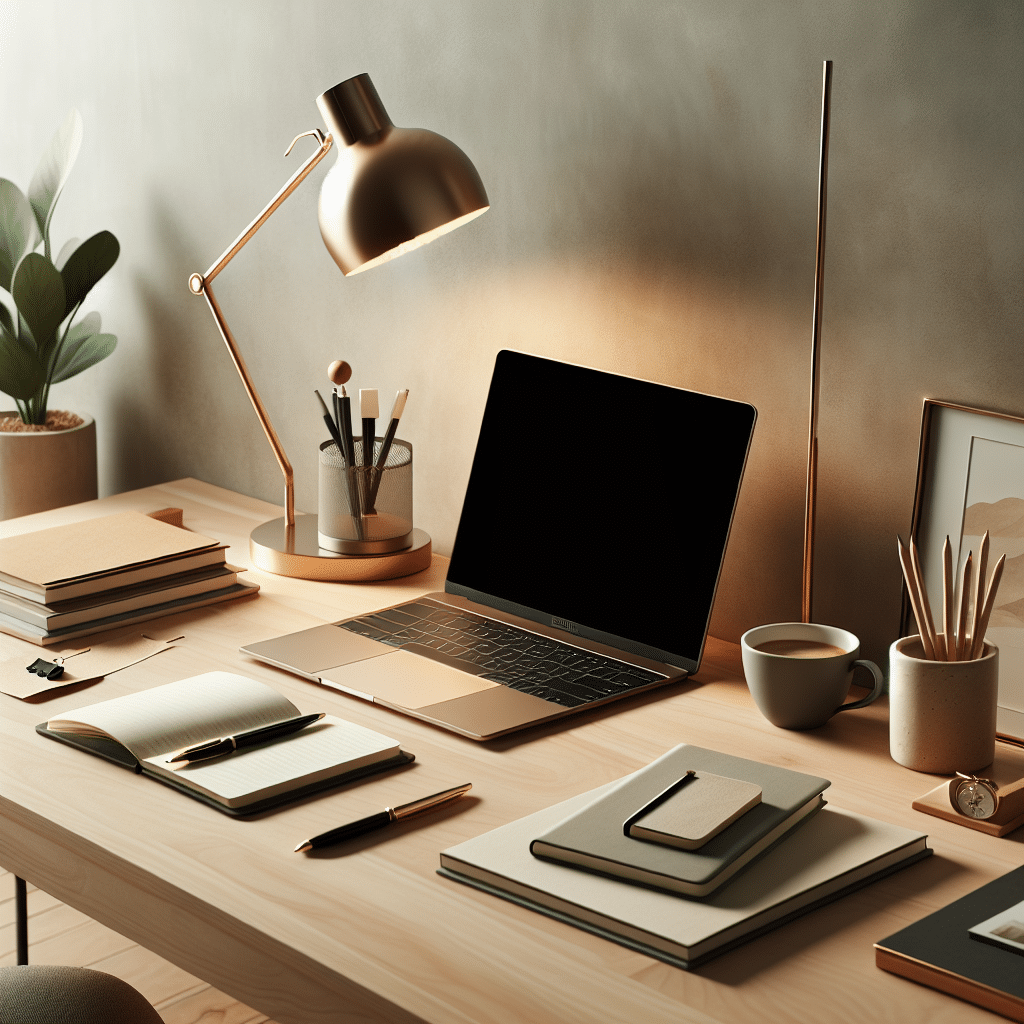The Importance of a Minimalist Desk Setup
A minimalist desk setup can profoundly impact productivity, focus, and mental clarity for remote professionals. By reducing visual clutter and emphasizing essential items, individuals can create a workspace conducive to creativity and efficiency. Below are strategies for implementing an effective minimalist desk setup.
1. Declutter Regularly
Regular decluttering is crucial. Start by removing all unnecessary items from your desk. Consider adopting the “one in, one out” rule: for every new item you bring into your workspace, remove one existing item. This practice prevents accumulation and keeps your space tidy.
- Daily Maintenance: Spend five minutes at the end of each day organizing your desk. Tuck away chargers, notebooks, and other miscellaneous items. This daily commitment helps maintain a clean workspace.
2. Choose Essential Tools Only
Assess the tools you require for everyday tasks. A minimalist setup thrives on functionality.
- Technology: Only keep devices that you use daily, such as a high-quality laptop or desktop computer. Accessories like tablets or additional monitors should be evaluated based on necessity.
- Stationery: Limit stationery items to a few essential tools, such as a quality pen, notebook, and sticky notes. Eliminate any tools that you rarely use.
3. Embrace Cable Management
Cables can quickly contribute to visual clutter. Effective cable management not only enhances the appearance of your workspace but also eliminates distractions.
- Cable Clips and Sleeves: Use clips to securely attach cables to your desk or table legs. Utilize cable sleeves or covers to keep multiple cables organized and visually appealing.
- Power Strips: Consider a sleek power strip that can be mounted under your desk. This keeps power cords off your working surface, allowing for a cleaner look.
4. Optimize Your Furniture
Choosing the right desk and chair significantly impacts your minimalist workspace.
- Quality over Quantity: Invest in a high-quality desk that suits your work style. A simple, sleek desk without drawers can help reduce clutter.
- Ergonomic Chair: Select an ergonomic chair that provides support for long hours of work while aligning with a minimalist aesthetic.
5. Limit Personal Items
While it’s essential to make your space feel inviting, minimizing personal items can aid concentration.
- Selective Decor: Choose one or two decor items that inspire you or hold significance, such as a framed photo or an art piece. Ensure they complement the overall minimalist color scheme.
- Plants: Consider including a small plant, which adds life without overwhelming your workspace.
6. Use Vertical Space Wisely
Utilizing vertical space smartly helps keep surfaces clear while maximizing functionality.
- Wall Shelves: Install floating shelves above your desk to store books or display decor. This keeps essential items out of direct sight yet within reach.
- Pegboards: A pegboard allows for flexible storage of tools and accessories, keeping them visible yet organized.
7. Implement a Docking Station
A docking station can streamline your workspace while minimizing cord chaos.
- Consolidated Connections: Use a docking station that connects to all your devices. This offers a single focal point for charging and connecting peripherals.
- Multi-Functionality: Look for docks that include USB ports, HDMI connections, and SD card readers, eliminating the need for multiple gadgets.
8. Color Scheme and Lighting
Adopting a cohesive color scheme enhances the aesthetic and emotional response to your workspace.
- Neutral Colors: Stick with a neutral palette for desks, walls, and furniture. Shades of white, gray, or beige encourage calmness and focus.
- Task Lighting: Invest in adjustable task lighting. A minimalist desk lamp reduces eye strain while providing adequate lighting for work without taking up too much space.
9. Time Management Tools
Incorporate simple time management tools to enhance productivity.
- Timer: Use a minimalist timer to help manage work sessions. This method can improve focus during dedicated work intervals (e.g., Pomodoro Technique).
- Digital Calendars: If paper planners contribute to clutter, switch to a digital calendar app that syncs across devices. This allows you to schedule your day without physical paper.
10. Create Zones
Establishing zones on your desk can enhance workflow and boost productivity.
- Work Zone: Dedicate one section solely for your computer and essential work materials. Ensure this zone is free from distractions.
- Study Zone: Reserve an area for reading or planning, equipped with a few books or your digital device. This segmentation helps prevent work-life overlap.
11. Personalize within Boundaries
Find the right balance between personalization and minimalism.
- Mood Boards: One option is to create a mood board or vision board that keeps you motivated. This can be hung on a wall or leaned against your desk, incorporating images or quotes that inspire you.
- Color Coordination: Personalize your office items, such as notebooks or digital accessories, by choosing items that match or complement your color scheme.
12. Regular Review and Adjustments
Finally, a minimalist desk setup should be regarded as a dynamic entity that requires regular evaluation.
- Monthly Check-ups: Set a date each month to evaluate what’s working and what’s not. Remove items that no longer serve a purpose or consider re-organizing your layout.
- Feedback Loop: Use feedback from your productivity levels as a guide to adjust your setup. If something feels off, don’t be afraid to experiment with changes.
By implementing these minimalist desk setup strategies, remote professionals can create an environment that promotes productivity, reduces distractions, and enhances overall well-being. A thoughtful approach to workspace design not only fosters efficiency but also contributes to a deeper sense of satisfaction in one’s professional life.
